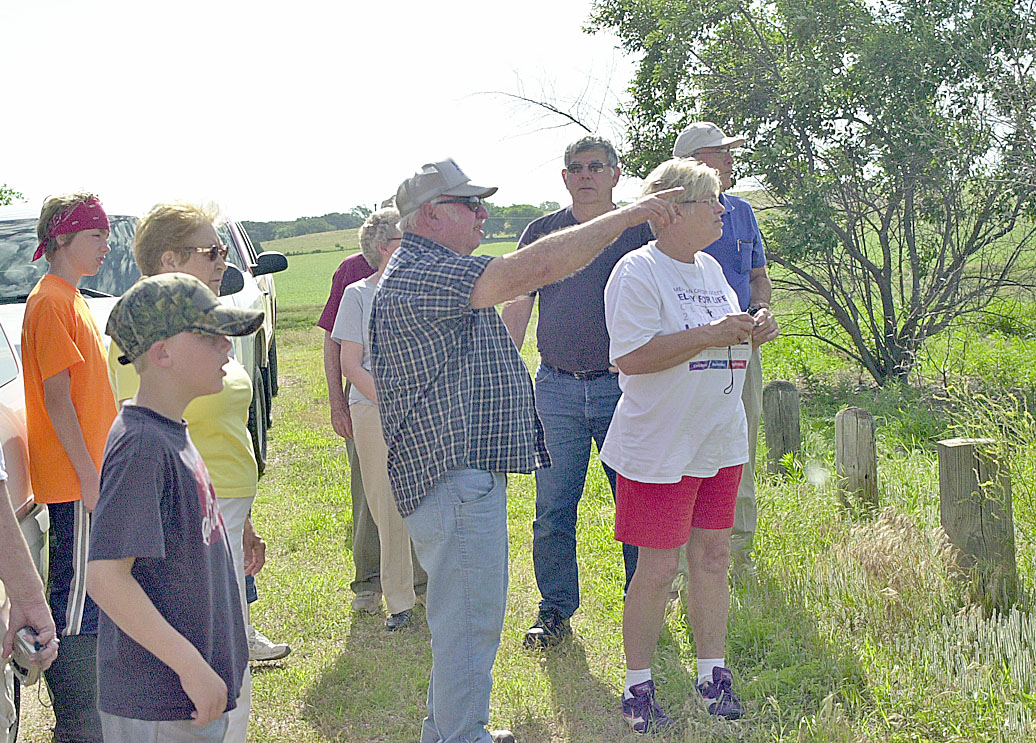Riding the river road

Jack Segelken grew up on River Road. He worked most of his life along the river it follows and he knows every square inch of the route like the back of his hand. He points to a sagging farm house bunkered against an old but newer home surrounded by rusty farm equipment, junk cars and scrap metal. “We lived there,” he says of his childhood home and adds in a half-whisper, “If my dad knew about all that junk just laying there, he’d turn over in his grave.”
Segelken is heading up a tour of Thayer County history buffs, some are members of the local Visitors Committee. “That field over there is where I went to country school,” he says. “It’s gone now.” He’s a quiet man, 70 years old, wears the tell-tale seed cap, plaid shirt and denim jeans common to the area and he clips along at a mighty steady gait as he relates stories from a time when he was much younger.
“One old boy made his whiskey there,” he says indicating a one-room stone structure along River Road. “They say his son went out to check it one day and found a drowned baby pig in the vat. When he told his dad he was going to fish it out, the old man said it didn’t make any difference, the pig was already pickled.” Jack chuckles and quickly points out trees lining the Little Blue River. “At night, along in those trees,” he says, “they say you can hear a woman scream.”
Although the “they” Jack refers to remains anonymous, he continues weaving a tale of fact, fiction and folklore bordering on the macabre as the tour makes its way along the gravel road. “We lived on the poor farm land when I was about six years old,” he says. That particular patch of ground is today a wildlife management area and as the tour group follows Jack to an ancient cemetery on the banks of Dry Creek, he says, “Every county had one for bums, tramps and the totally insane.”
As the group picks its way through the 70-year old headstones, they are surprised to find two of them decorated with pink plastic flowers. Some stones are marked with numbers, most have none; there are 16. “What bothers me is something ate a deer out here,” Jack says alluding to perhaps a large predatory-type animal or maybe something a bit more ghostly. “And over there by that stone, in December there was a big black snake lying on the snow and when I got close to it, it slipped down a hole into the grave. It’s kind of unusual for a snake to be seen in winter, don’t you think?” The group looks down, sandaled feet begin to shift, the grass is tall today; there could be a snake anywhere.
Jack hides his smile and leads the group back to an old limestone “Missouri crossing” that runs across the Dry Creek just before it joins the Little Blue River. “The Oregon Trail runs just north of here,” he says, “and some of the best ground for farming is here. My dad had $3,000 buried in the barn that used to stand here.”
As the group heads to another old cemetery, Mt. Gilead, tales of an ambushed stagecoach driver and a couple of famous bandits emerge along the way:
Hebron Journal-Register, Oct. 3, 1984: On a bluff overlooking the Little Blue River just north of the old Wallace Bridge eight miles east of Hebron on the River Road, lies the grave of a stagecoach driver killed by Indians 120 years ago.
The driver was Charles Kennedy, who as historians recall, was driving the stage alone on a westward course on the Overland Trail; however, Nebraska State Historical Society considers the Oregon Trail to be ten miles wide so the Overland Trail may have actually been a part of the Oregon Trail.
Legend has it, the Indians ambushed him from a thicket with rifle fire. He was found by friends some time later, who buried him where he fell.
Jack recounts some of Thayer County’s most famous folklore about bandits Frank and Jesse James. “They used to play ball over at Alexandria,” he says and points to a gated area near the Mt. Gilead entrance. “They say their sister lived over in there. You can still see the foundation of the house.”
Others in the group confirm the legend although no official account of the two bank robbers visiting here is recorded anywhere. State records and census reports, however, indicate the outlaws had cousins in Jefferson and Thayer counties and that their mother lived in Rulo. Also true is that Jesse James wanted to buy land in south-central Nebraska near Franklin and using the name Thomas Howard inquired about the property. It was said he wanted to go straight and become a farmer, but before he could inspect the land for possible purchase, Robert Ford shot him dead in St. Joseph, Mo.
River Road winds its way from Hebron to Gilead carrying memories for some, history for others, a special glimpse into Thayer County for all. To investigate its folklore visit the Thayer County Museum, open Wednesday and Saturday afternoons, 2-4 p.m., where a wealth of information is stored. Curators can get you in touch with Visitor Committee members or the Thayer County Historical Society for special tours.
And if you run into Jack, ask him about the old guy who swore he saw “Bigfoot” peeking out at him over his field of corn. Whether you think the old guy got into the pickled pig hootch before spying the Yeti or not is up to you. Jack’s just passing on what he’s heard. “It’s what they say,” he’ll tell you, and sure as anything you’re liable to believe him. At the very least, you’ll smile.



